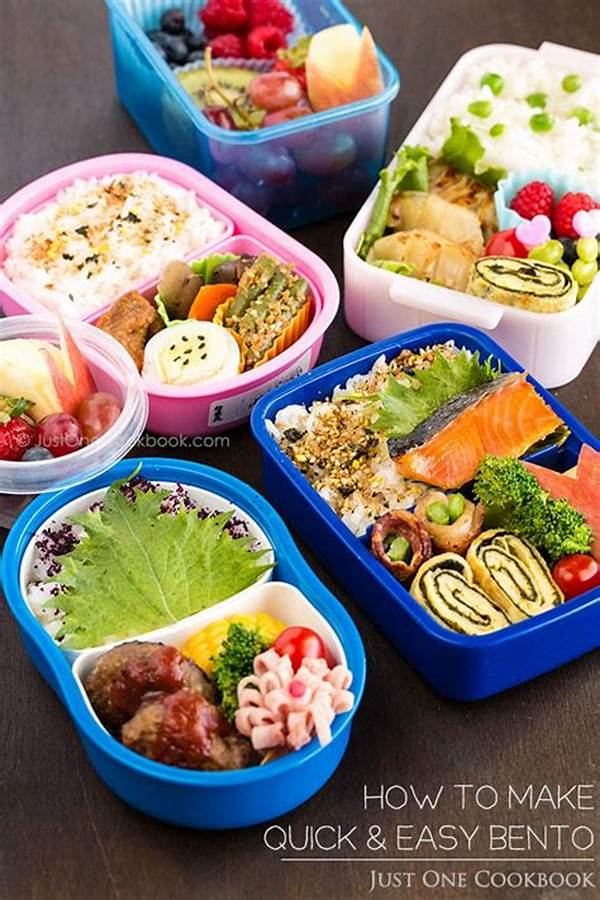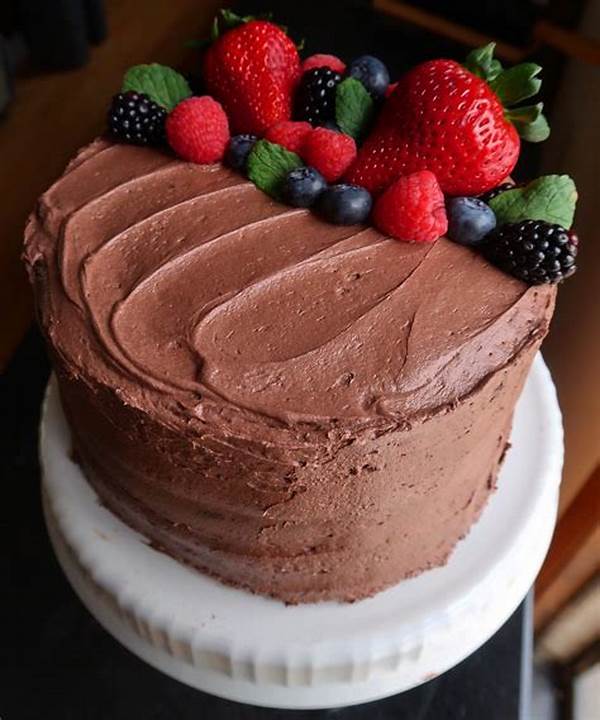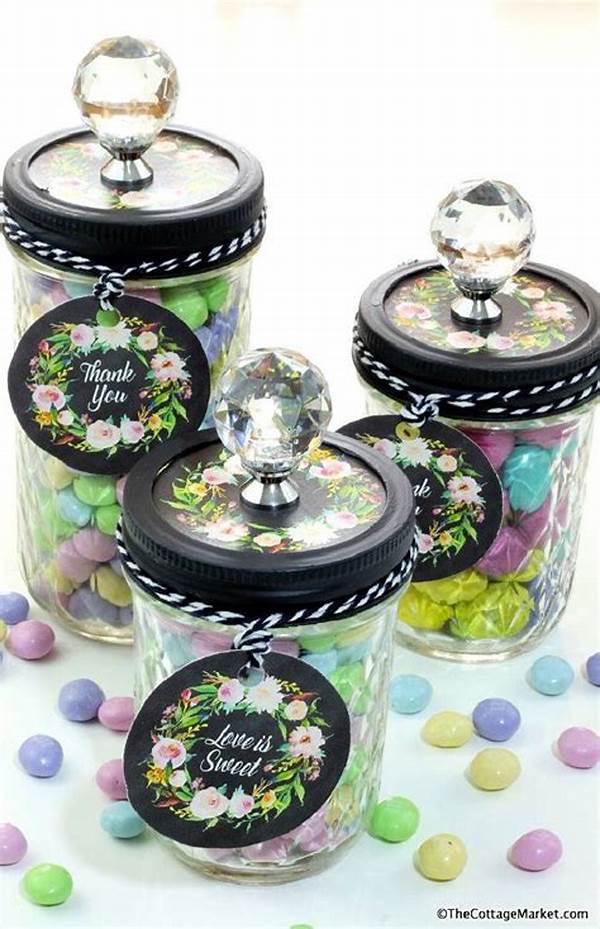In the quiet town of Sakai, nestled within the rolling hills and cherry blossom trees, there lived an elderly lady, known by the locals as Grandma Yuki. Her family bento boxes had long been the heart of every family’s outing, a sweet reminder that simplicity and love were the two main ingredients of any traditional meal. As each day began, she would meticulously prepare the contents of each bento box, a tradition passed down from her ancestors. Her kitchen, full of the rich aroma of steaming rice and simmering miso soup, was the heart of countless family stories.
Read Now : Food Truck Menu Ideas That Sell
The Art of Crafting a Perfect Bento
Grandma Yuki always said that the secret to a perfect bento was balance. Not just in taste, but in color and texture as well. As she sliced the freshly harvested vegetables, she recounted tales of her own childhood, where she first learned these essential traditional bento preparation tips. Mixing the wooden ladle in a pot of simmering rice, she would blend different ingredients, creating a harmony of flavors. Her story wasn’t just about food; it was about love, care, and the passing down of culture through generations.
One sunny morning, as Grandma Yuki prepared bentos for a local festival, she chuckled as she recalled her first attempt at feeding ten hungry cousins. “You see,” she said, while carefully shaping the rice balls, “it’s not just about cooking; it’s about crafting memories.” She reminded her granddaughter, who watched attentively as the old woman moved gracefully through the kitchen, that these traditional bento preparation tips were not just for the taste buds, but for the soul. The meticulous steps she took with each meal were stories she relived, layered with flavor and nostalgia.
Techniques Passed Down Through Generations
1. Grandma Yuki believed in using seasonal produce, which she considered one of her vital traditional bento preparation tips. She always began her day at the local market, choosing only the freshest ingredients.
2. The balance of colors was crucial. Each bento Grandma Yuki created was akin to a painter’s palette as she mixed vibrant hues, a testament to her eye for beauty.
3. It was important for Grandma Yuki to focus on symmetry, a traditional bento preparation tip she regarded as essential. Her rice was expertly packed, with tidy shapes and neat compartments.
4. A blend of textures created an enjoyable eating experience. Crunchy, soft, and chewy elements were combined in a skillful way to delight the senses and elevate the dining experience.
5. Portion control was key. Grandma Yuki taught that a well-prepared bento should contain just enough, leaving the eater satisfied yet not overly full.
The Soulful Ingredients of a Traditional Bento
Each bento Grandma Yuki assembled told its own story, mirroring the elements of life itself. By integrating her traditional bento preparation tips, she ensured that every bento was a feast for both the eyes and the palate. Her rice, a staple, was carefully steamed to perfection as it formed the canvas for other ingredients. Pickled vegetables added color, zest, and tradition, bringing with them a tangy flavor that captivated everyone who tasted them.
Alongside the vegetables, crispy tempura stood proudly, a favorite fried delicacy that always drew eager hands towards the box. Every element had a purpose, a role to play in the ensemble that was lunch. Grandma Yuki’s storytelling extended to these beloved rice balls, which were carefully molded into delightful shapes and filled with surprises like salted salmon or savory plum. Each bite was a step back into simpler times, narrating tales of family and warmth with every chew.
Read Now : Weight Loss Vegan Protein Tips
Crafting Stories Through Bento
Creating a bento box is akin to writing a story. Grandma Yuki understood this, and her traditional bento preparation tips were based on layering details that transformed a meal into a narrative. Her stories were written with fish flakes and sweet tamagoyaki, which glistened like the sun as they unrolled their flavor, bite by delicious bite.
Each tiny compartment in the bento box was a new chapter, holding Grandma Yuki’s history within it. The tantalizing aroma of grilled eel was an homage to her mother, who passed down the recipe on a chilly autumn night. Carefully cooked and seasoned, the food conveyed warmth and gentility. Unveiling each section of the bento was an unwrapping of cherished memories, each taste a vivid story embellished with sentiment.
The storytelling aspect of preparing bento was a journey, Grandma Yuki often mused, without a tangible beginning or an ending. Her gentle hands were seasoned with time, and they crafted meals with a patient rhythm—a dance of fingers that knew exactly how to coax the best taste from any ingredient.
The Heartbeat of Tradition
In the gentle light of a Sunday morning, Grandma Yuki’s kitchen was a sanctuary. It was here that she shared her world of traditional bento preparation tips with anyone eager to listen. Her laughter, a sweet song that accompanied the scratch of knife against bamboo cutting boards, spoke of her effortless joy. She knew that these tips were more than culinary advice; they were lifelines, strings connecting her to ancestors and descendants alike.
Her granddaughter often marveled at how something as simple as rice and vegetables could hold the power to weave hearts together. Tradition wasn’t just inherited through recipes but through the very act of creating something beautiful out of humble beginnings. And as Grandma Yuki placed the freshly prepared bento box into eager hands, she knew she was bestowing a piece of her soul.
In this way, the traditional bento preparation tips she imparted were lessons in love, resilience, and the enduring power of family. The kitchen was her classroom, and each meal a testament to how food, interwoven with care, could nurture and preserve life’s most valued stories. Transferred from generation to generation, these bentos told a tale as old as time, resonating with anyone fortunate enough to savor them.




